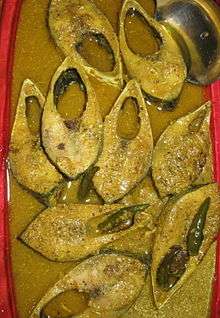Bangladeshi cuisine
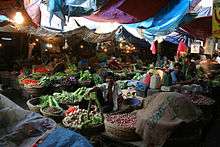
Bangladeshi cuisine (Bengali: বাংলাদেশের রান্না) is the national cuisine of Bangladesh. It is dominated by Bengali cuisine and has been shaped by the diverse history and riverine geography of Bangladesh. The country has a tropical monsoon climate.
Rice is the main staple food of Bangladesh and is served with a wide range of curries. Sublime Bangladeshi dishes exhibit strong aromatic flavors; and often include eggs, potatoes, tomatoes and aubergines. A variety of spices and herbs, along with mustard oil and ghee, is used in Bangladeshi cooking. The main breads are naan, paratha, roti, bakarkhani and luchi. Dal is the second most important staple food which is served with rice/porota/luchi. Fish is a staple in Bangladeshi cuisine, especially freshwater fish, which is a distinctive feature of the country's gastronomy. Major fish dishes include (ilish), pabda (butterfish), rui (rohu), pangash (pangas catfish), chitol (clown knifefish), magur (walking catfish), bhetki (barramundi) and tilapia. Meat consumption includes beef, lamb, venison, chicken, duck, squab and koel. Vegetable dishes, either mashed (bhurta), boiled (sabji), or leaf-based (saag), are widely served. Lobsters and shrimps are also often prevalent.
Gourmet pulao is served during feasts and festivals. Different types of Bengali biryani and pulao include Kachi (mutton), Tehari (beef), Ilish and Murg (chicken). Different types of kebabs include shikh, reshmi, shashlik, tikka and shami. The country is home to a huge spread of Bengali desserts and confectioneries, ranging from pan-fried or steamed rice cakes (pitha) to halwa and sweets made from fruits and sweetened cheese. Tea is widely consumed as the national beverage and offered to guests as a gesture of welcome. Popular snacks include samosas, pakoras,jhalmuri(puffed rice mixed with various spices), pitha(rice cakes),rolls etc.. The phuchka and "chotpoti" are major street foods. The Chittagong Hill Tracts in southeastern Bangladesh features bamboo shoot cuisine. Bangladesh is also the world's fifth-largest producer of tropical fruits.
History
Ancient Bengali diets included rice, fish, honey, dairy and vegetables. The region was an administrative and commercial bastion in South Asia during early Hindu and Buddhist kingdoms; and later Muslim sultanates. Mughlai cuisine developed in Bengal after the establishment of the province of Mughal Bengal in 1576, as part of the Mughal Empire. The city of Dhaka played an important role in influencing Bengali food with Mughal elements. The British Empire ruled the region for nearly two hundred years between the 18th and 20th centuries, during which the Bengal Renaissance shaped the emergence of modern Bengali cuisine. During the British Raj, Calcutta influenced many Bengali dishes. In the southeast, Arakan cuisine from Burma influenced dishes in Chittagong, particularly dried fish.
The Partition of Bengal in 1947 resulted in the separation of West Bengal from the Muslim-majority East, causing many shifts in demographics and culinary styles. Today, as opposed to the largely vegetarian cuisine in West Bengal, there is a greater emphasis on meat in Bangladesh.
Bangladeshi cuisine incorporates a large number of cosmopolitan influences, a legacy of the region's historic trade links with the Arab world, Persia, Portugal, the United Kingdom, and Burma. The Portuguese in Dhaka developed cheese. The British introduced tea.
Halal
Islamic dietary laws are prevalent across Bangladesh. Halal foods are food items that Muslims are allowed to eat and drink under Islamic dietary guidelines. The criteria specifies both what foods are allowed, and how the food must be prepared. The foods addressed are mostly types of meat allowed in Islam.
Bengali Keta
Bangladeshi people follow certain rules and regulations while eating. It includes warm hospitality and way of serving as well. This is known as Bengali Keta. The culture also defines the way to invite people in weddings and for the dinner as well. The gifts are given on different occasions. The Bengali Keta includes the way of serving the utensils in a proper manner.[1]
Regional cuisines
In Bangladeshi cuisine, some foods are popular across the entire region, while others are specific to a particular area.
Western region
The western areas mainly include the Khulna and Jessore areas and is very close to the West Bengal of India (the second highest region of Bengalis in the world). The cuisine of these areas are known as authentic Bengali recipes. Mug dal with hilsha fish head, dalna, chachari, luchi-payesh, hilsha with mustard, etc. are very popular in both the east and west parts of Bengal.
Northern region
The northern part of Bangladesh has strong influences from Eastern Indian states, such as Assam and Manipur. The main characteristic of this food is that it is mainly sweet and has a lot of uses of banana throats, raw papaya fruit, raw mango, urad lentils and grilled or smoked vegetables.
Central region
The capital Dhaka and its territory region make up the central region, where fresh water fish are much more popular. Due to different ruling periods, the cuisine of this region is versatile. The Old Dhaka area is famous for the Nawab Awadhi cuisine. In Old Dhaka, kebabs, naans, bakharkhani, kachchi and pakki biriyani, haleem, mutton bhuni kichuri, and specialty mutton tehari are examples of dishes that became popular in other parts of the country.
Eastern region
The staples of Sylheti people are mainly rice and fish. Their choice and method of cooking is distinctly different to non-Sylhetis. Traditional foods include sour dishes, such as tengha (or tok) cooked with vegetables, including amra, defal, olives (belfoi), dewwaa, amshi, mango choti (aam choti), kul (boroi), hatkhora (or shatkora), ada zamir (ada lembu), and any other sour lemon-like tasty vegetable. The 360 disciples mentioned earlier brought their distinct cultures and cooking styles. These included many types of meat dishes, including chicken.
Southern region
The Southern region of Bangladesh includes the tribal areas that have their own style of cooking methods and ideas. Other than that, the most southern part of this region is mainly influenced by the Arakan cuisine of Burma. Dried fish (shutki), bamboo shoots, sea fish, and many more are the specialties. They use lots of spicy flavors and coconuts in their food preparations.
Main ingredients
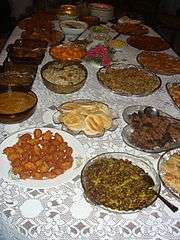
- Riverine Areas: Bengal's main staple food of sweet water fish comes from this riverine region. Every river in Bangladesh is fulfilled with thousands of types of fish. Ilish, Rui, Katol, Koi, Papda, Boal, Citol, Magur, Sing, Mola, Dhlea, etc. are favorites to all. Bangladesh's "Paddar Ilish" (Padma Ilish) is famous all over the world.
- The staples of Bangladeshi cuisine include rice, which is a common component of most everyday meals[2] and, to a lesser extent, "ruti" (an unleavened whole wheat bread).
- "Atta" (a unique type of whole ground wheat flour) is used for making Luchi, Porota, Pitha, etc.
- Lentils/Pulses (legumes) includes at least five dozen varieties; the most important of which are Bengal gram (chhola), pigeon peas, red gram, black gram (biuli), and green gram (mung bean). Pulses are used almost exclusively in the form of 'dal', except 'chhola', which is often cooked whole for breakfast and is processed into flour (beshon).
- As a tropical country, a wide variety of green vegetables and fruits are available in Bangladesh. A host of gourds, roots and tubers, leafy greens, succulent stalks, citrons and limes, green and purple eggplants, red onions, plantains, broad beans, okra, banana tree stems and flowers, lotus roots, green jackfruit, red pumpkins, and mushrooms are to be found in the vegetable markets or kacha/sabji bazaar.
- Local and hybrid chicken, beef and mutton dishes are favorites across Bangladesh, as well as bird dishes, such as group duck and pigeons.
Rajshahi & Northern Regions: Rajshahi mangoes are considered to be the best in the country. Sweet dishes are also popular. The Northern parts of the country is also renowned for growing pineapple, guava, watermelon, white or sweet melon, green bell apple, wood apple (kotbel), tropic grape, jujube (kul/boroi), pear, litchi, carambola (kamranga), etc.
Sylhet: A citrus fruit called shatkora is sometimes used in meat dishes. Freshwater fishes are more readily available than saltwater ones.
Chittagong and Southern Regions: Ziafat or Mezban feasts are popular throughout the area, where characteristic "heavy" dishes—dishes rich in animal fat and dairy—are featured. Saltwater fish and seafood are quite prevalent in these areas. Shutki (dried fish) is more available in this region than in other parts of the country. Bangladesh's Southern region is also popular worldwide for its fisheries industries with over 100 types of fishes exported every day from this region.
Barisal and Khulna: Piper chaba is a flowering vine in the family Piperaceae. It is called "Chui Jhal" in Bangladesh. Chui Jhal is originally the twig of a Piper chaba. It is a very expensive spice in Bangladesh, has great medicinal value, and tastes somewhat like horseradish. People in Khulna, Bagerhat, and Shatkhira cut down the stem, roots, peel the skin and cut it into small pieces and cook them with meat and fishes, especially with mutton. They love the spicy pungent flavor of spice all year round. A wide range of sweet water fishes are available in this region, which are highly famous all over the country.
Cooking medium and spices
Mustard oil and vegetable oil are the primary cooking mediums in Bangladeshi cuisine, although sunflower oil and peanut oil are also used. However, depending on the type of food, clarified butter (ghee) is often used for its aromatic flavors.
Bangladeshi food varies between very sweet and mild to extremely spicy. It resembles food found in other parts of Asia. There are also slight similarities with South East Asian and North East Indian food customs. The most common condiments, herbs and spices in Bangladeshi cuisine are garlic, onion, ginger, turmeric, ghee, coriander, cumin, dry bay leaves, chili pepper, and chili powder.
The pãch poron is a general purpose spice mixture composed of fenugreek seeds, nigella seeds, cumin seeds, and black mustard seeds. This mixture is more convenient for vegetarian dishes and fish preparations.
The use of spices for both meat and vegetable dishes is quite extensive and includes many combinations. The combination of whole spices, fried and added at the start or finish of cooking as a flavoring is special to each dish. Whole black mustard seeds and freshly ground mustard paste are also a typical combination. A pungent mustard sauce called kashundi is sauce for snacks or sometimes makes a base ingredient for fish dishes and vegetable dishes popular in Bangladesh.
Common Bangladeshi recipe styles

The following is a list of characteristic Bangladeshi recipe styles. Each entry is a class of recipes, producing different dishes depending on the choice of ingredients. There are tastes to which the Bangladeshi palate cater to. These include:
- Achar: Assortment of pickled fruit, vegetables or spices. Generally flavored with mustard oil, mustard seeds, aniseeds, caraway seeds, and asafoetida or hing.
- Bawra (বড়া): Anything that has been mashed, mixed with thick batter and then formed into a rough roundish shape and deep fried, generally in soybean or mustard oil. Generally it is served with rice as a starter, or served with puffed rice crisps or as a single snack. The bora has quite a few kinds. When potatoes are fried in a light chickpea flour batter, they are called fuluri (giving rise to the Trinidadian pholourie).
- Bhaja (ভাজা): Anything fried (especially potato, aubergine, cauliflower, cabbage, fish, chicken) after it has been salted or dipped in any kind of water-based batter. Does not include croquettes or crumb-coated items.
- Bhapa (ভাপা): Fish or vegetables steamed with spices.
- Bhate (ভাতে): A vegetable that has been put in the pot where rice is cooking. It is cooked with the rice. Generally, the vegetable includes potatoes, butternut squash, raw papayas, bitter gourd, snake gourd and okra. It is often eaten with a tinge of mustard oil or ghee and salt. For this, generally "atap chawl" rice is used. It's is a short-grained, glutinous rice that cooks quickly and preferred because of its creamy quality and ability to become sticky. That aids the dish when it comes to mashing. At serving, fresh ghee or butter, and salt to taste, is mixed and mashed by hand and then eaten. A raw green chili, and a boiled and shelled egg, sometimes accompany this dish.
- Bhorta (ভরতা): Any vegetable, such as potatoes, aubergine, beans, sour mangoes, papaya, pumpkins and shrimp, dried fig or even dal, first boiled whole and then mashed and seasoned with red shallot, fresh chili, mustard oil/ghee and spices.
- Chap (চাপ): Bengali-style croquettes, usually coated with crushed biscuits or breadcrumbs.
- Chutney: Generally, the Bengal region is one of the pioneers for this dish, making it with everything, including preserved mango sheets, called amshotto.
- Dom (দম): Vegetables, especially potatoes, or meat, cooked over a covered pot containing water, slowly over low heat, slightly steaming. The word is derived from the dum technique popular in Mughlai cuisine.
- Ghonto (ঘন্ট): Complementary vegetables (e.g., cabbage, green peas, potatoes, banana blossom, coconut, chickpeas, etc.) are chopped or finely grated and cooked with pouron and ground spices. Dried pellets of dal are often added to the ghonto. Ghee is commonly added at the end. Non-vegetarian ghontos are made, with fish or fish heads added to the vegetables. The famous muri ghonto is made with fish heads cooked in a fine variety of rice. Some ghontos are very dry while others are thick and juicy.
- Kalia (কালিয়া): A very rich preparation of fish or meat using a lot of oil or ghee with a spicy sauce usually based on ground ginger and fresh shallots pasted or fried along with a tempering of gorom moshla.
- Kofta: Ground meat croquettes bound together by spices or eggs, served alone or in savory gravy.
- Korma: It involves egg, fish or meat cooked in a mild yogurt-based sauce with ghee, and often poppy seed paste is added. People of southern Bangladesh add coconut milk to many of their dishes and korma is no exception.
- Paturi: Generally, oily fish is sliced evenly and wrapped in a banana leaf, after the fish has been basted with freshly pasted mustard with a hint of mustard oil, chili, turmeric and salt.
- Posto: Anything (especially potato, aubergine) cooked with poppy seed paste as the main flavoring agent. Often poppy seed paste with some mustard oil is eaten mixed with rice all by itself as a mild beginner in a meal.
- Shak (শাক): Green leafy vegetables, like spinach and mustard greens, are shredded and cooked until they wilt in a touch of oil and tempering of nigella seeds.
- Torkari: A general term often used in Bengali, the same way 'curry' is used in English. The word first meant uncooked garden vegetables. From this, it was a natural extension to mean cooked vegetables or even fish and vegetables cooked together.
Bangladeshi meals
Each dish is to be eaten separately with a small amount of rice or ruti, so that individual flavors can be enjoyed. The typical Bangladeshi fare includes certain sequences of food. Two sequences are commonly followed, one for ceremonial dinners, such as a wedding, and the other for day-to-day sequence. Both sequences have regional variations, and sometimes there are significant differences in a particular course in Bangladesh.
Ceremonial occasions, such as weddings, use to have elaborate serving rituals, but professional catering and buffet-style dining can be seen now. The traditions have not disappeared; large family occasions and the more lavish ceremonial feasts will still have the same traditional rituals.
Main course
Bangladeshi foods contain staples, such as rice and flat breads. Different traditional flat breads include Luchi, Porota, Bakhorkhani, Nan, Ruti, Rice Flour Flatbread, Chitai Pitha, and many more. Dishes made from chicken, beef, fish or mutton, as well as dal (a spicy lentil soup) and vegetables commonly accompany rice and flat breads. Traditional dishes can be 'dry', such as gosht bhuna (chicken/beef/mutton). Items with jhol (gravy) are often curried. Bangladeshi cuisine frequently uses fresh vegetables, which generally vary with season. Vegetables are also used for light curries.
On special occasions, such as weddings or other similar ceremonies, Bangladeshi people serve guests with Biryani, which is very popular in the cities and urban areas, and Borhani, which is a spicy drink that is known to aid digestion.
Chutney
In Bengali cuisine, Chutney is mainly served at the end of a meal. It is a sweet & sour thickened curry usually made with local seasonal fruits, such as raw mango, jujube, Bengal quince, etc. with pãch poron (five mix spices) and sugar.
Desserts
Bengalis take pride on their desserts. Bengalis are the pioneers of making and inventing a variety of sweets in the Indian Subcontinent (pre-partition period). Most of these sweets have been created by a Ghosh (a dessert maker or dairy product seller cast).
The last item before the sweets is Doi (baked yogurt).[3] It is generally of two varieties, either natural flavour and taste or Mishti Doi (sweet yogurt), typically sweetened with charred sugar. This brings about a brown colour and a distinct flavour. Bangladeshi cuisine has a rich tradition of sweets. The most common sweets and desserts include:
- Rasgulla - Rasgulla, locally pronounced "Roshogolla" or "Rashgolla", is a sweet made with channa (posset/curdled milk) and sugar syrup. It is one of the most widely consumed sweets. The basic version has many regional variations.
- Channer Shondesh is a dessert created with milk and sugar.
- Chhanar Mishti - A sweet made from chickpea flour with sugar/jaggery/molasses. Nowadays, there are various types of Chhanar Mishthi available all across Bangladesh.
- Mishti Doi - Sweetened homemade creamy yogurt; prepared by boiling milk until it is slightly thickened, sweetening it with sugar, either guda/gura (brown sugar) or khajuri guda/gura (date molasses), and allowing the milk to ferment overnight.
- Naru - It is usually home-made and used as offerings in Hindu rituals of praying to their Gods.
- Rosh-malai - Small rashgollas in a sweetened milk base; Comilla is famous for its Rosh-malai.
- Khaja - Deep fried sweets made from wheat flour and ghee, with sugar and sesame seeds as the coating.
- Mua - Cooked with rice flakes and jaggery.
- Hawai'i Mishti - Made with sugar and given various forms.
- Chhana is fresh, unripened curd cheese made from water buffalo milk.
- Chhaner jilapi - Made in a manner very similar to regular jalebi except they are made with chhana.
- Khir is a common Bangladeshi sweet dish. Phirni, together with Zarda, is also typical during Shab-e-Barat and Eid. It is cooked with dense milk, sugar/jaggery, and scented rice (kalijira rice). Although it takes a lot of time to cook, it is one of the main features of Bangladeshi desserts. A thicker version of khir is used as filling for pitha.
- Gurer Shondesh is a fritter made from rice flour and palm sugar.
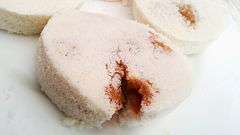
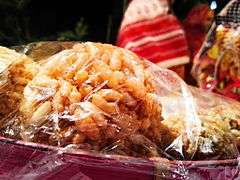
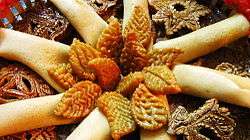
- Goja - A light sweet snack made from flour and sugar, and often served as street food, which is consumed both as dessert and starter.
- Chômchôm (চমচম) (originally from Porabari, Tangail District in Bangladesh) – This sweet goes back centuries. The modern version of this oval-shaped sweet is reddish brown in colour and has a denser texture than the rôshogolla. It can also be preserved longer. Granules of maoa or dried milk can also be sprinkled over chômchôm.
- Shemai - It is made with vermicelli prepared with ghee or vegetable oil.
- Balushahi is made from a stiff dough made with all-purpose flour, ghee and a pinch of baking soda. One-inch-diameter (25 mm), 1⁄2-inch-thick (13 mm) discs are shaped with hands, fried in ghee or oil and dunked in thick sugar syrup so that there is a sugar coating. They are very sweet, but tasty with a slightly flaky texture.
- Piţha - In Bangladesh, the tradition of making different kinds of pan-fried, steamed or boiled sweets, lovingly known as "piţhe" or "pitha",[4] still flourishes. These little balls of heaven symbolises the coming of winter, and the arrival of a season where rich food can be included. The richness lies in the creamy silkiness of the milk, which is often mixed with molasses or jaggery made from either date palm or sugarcane, and sometimes sugar. They are mostly divided into different categories based on the way they are created. The most common forms of these cakes include bhapa piţha (steamed), pakan piţha (fried) and puli piţha (dumplings), among others. The other common pithas are chondropuli, gokul, pati shapta, chitai piţha, aski pitha, muger puli and dudh puli. Generally, rice flour goes into making the pitha.
Beverages
- Akher gur Shorbot – sugarcane juice with jaggery
- Akher Rosh – sugarcane juice
- Borhani – a spicy drink usually served in gatherings, banquets and weddings. It aids digestion.
- Ghol – whisked salted milk
- Jeera pani – a drink boasting fresh, lively flavors and generally served as an appetizer or welcome drink.
- Khejur Rosh – date palm juice
- Tea
- Malai
- Faluda
- Mango juice (Amer shorbot)
- Watermelon juice (Tormujer shorbot)
- Juice of Bengal quince (Bel er shorbot)
See also
References
- ↑ Bangladesh - Language, Culture, Customs and Etiquette
- ↑ Tukeda, Jun (2007-08-31). "Spices in Sri Lanka, India and Bangladesh with Special Reference to the Usages and Consumptions" (PDF). Bull. Fac. Agr., Saga Univ. (93): 1–25. Retrieved 2014-08-14.
- ↑ "Pure Cambogia Ultra Sandesh".
- ↑ "Nobanno Pitha".
Further reading
- Bangladeshi Restaurant Curries, Piatkus, London — ISBN 0-7499-1618-4 (1996)
- Curries - Masterchef Series, Orion, London — ISBN 0-297-83642-0 (1996)
- Curry, Human & Rousseau, South Africa — ISBN 0-7981-3193-4 (1993)
- Kerrie, in Afrikaans, Human & Rousseau, South Africa — ISBN 0-7981-2814-3 (1993)
- Petit Plats Curry, French edition, Hachette Marabout, Paris — ISBN 2-501-03308-6 (2000)
- 2009 Cobra Good Curry Guide, John Blake Publishing, London — ISBN 1-84454-311-0
- Bangladesh - Mariam Whyte, Yong Jui Lin
- World and Its Peoples: Eastern and Southern Asia - Marshall Cavendish Corporation -
- Bangladesh - Stuart Butler
- Bangladeshi Cuisine - Shawkat Osman
- Multicultural Handbook of Food, Nutrition and Dietetics

